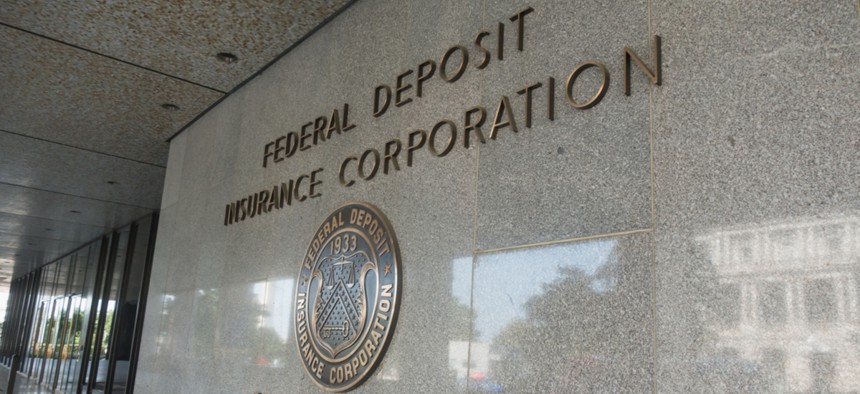FDIC’s Top 3 Challenges Are All Tech Related

bakdc/Shutterstock.com
Among the financial regulator’s biggest challenges, IT modernization and cybersecurity topped the list.
The Federal Deposit Insurance Corporation could solve its top three most pressing challenges by addressing issues with its oversight of cybersecurity and emerging technologies, according to a report from the agency’s inspector general.
“The FDIC plays a critical role in maintaining the stability of our financial system, and in protecting the savings of millions of Americans,” FDIC Inspector General Jay Lerner wrote, noting the agency insures more than $7.4 trillion at some 5,400 banks. In order for the FDIC to meet this mission, the agency must ensure the security of its own systems, as well as the systems of the banks it oversees.
The top three management and performance challenges for FDIC, according to the IG, are:
- Enhancing oversight of banks’ cybersecurity risks.
- Adapting to financial technology innovation.
- Strengthening FDIC information security management.
As part of its oversight responsibilities, the FDIC conducts regular assessments of banks’ cybersecurity posture through a program called Information Technology Risk Examination, or InTREx. Since the InTREx process was adopted in 2016, FDIC bureaus have reported a significant increase in the time it takes to conduct an examination, according to the report.
For example, the New York regional office reported a 67 percent increase in examination time, “adding an extra 80 hours to the examination,” the report states. FDIC officials told the IG the agency is staffing up in response, adding 23 full-time positions in 2019.
The IG also warned of the significant threat from third-party technology service providers that work across the financial sector.
“Significant consolidation among [third-party service providers] caused large numbers of banks—especially community banks supervised by the FDIC—to rely on a few large service providers for core systems and operations support,” the IG wrote. “As a result, a cybersecurity incident at one TSP has the potential to affect multiple financial institutions.”
FDIC regulations require banks to audit these third-party companies’ cybersecurity measures, however, the IG “did not see evidence, in the form of risk assessments or contract due diligence, that sampled financial institutions fully considered and assessed the potential impact and risk of TSPs,” the report states.
One reason financial institutions tap third-party providers is their ability to stay on the leading edge of the technological curve. While they introduce some risk, the IG’s second priority for the coming year focuses on the need to adopt these new technologies and create flexible regulations that can adapt in kind.
While technology continues to evolve across sectors, the IG report notes several emerging technologies specific to the financial sector, such as mobile wallets and digital currencies.
“According to the Department of the Treasury, from 2010 to 2017, more than 3,330 new technology companies were formed to serve the financial industry,” the report says. “The Treasury Department also estimated that one-third of online U.S. consumers use at least two financial technology services—including financial planning, savings and investment, online borrowing or some form of money transfer and payment.”
These technologies pose three significant risks: the cybersecurity of the tech, as well as the companies providing these products and services; the operational risks of using new tech that might not be in compliance with federal regulations; and falling behind the curve as technologies like blockchain and cryptocurrencies upend the traditional models banks have come to rely on.
“The FDIC should ensure that banks have proper governance and risk management practices around these technologies,” the IG said, suggesting an increase in the number of examiners and improved training on the latest emerging tech.
Finally, the report stresses the importance of looking inward to ensure FDIC itself isn’t the weak link in the cybersecurity chain. As the clearinghouse for information on much of the financial sector, the FDIC is a prime target for bad actors.
“The FDIC maintains thousands of terabytes of sensitive data within its IT systems and has more than 180 IT systems that collect, store or process personally identifiable information of FDIC employees; bank officials at FDIC-supervised institutions; and bank customers, depositors and bank officials associated with failed banks,” the report notes. “FDIC systems also hold sensitive supervisory data about the financial health of banks, bank resolution strategies and resolution activities.”
In fact, in recent years, several retiring FDIC employees were found to have taken hundreds of thousands of records on American banks and citizens, some of whom brought that data to their next jobs at foreign financial institutions. Prior to that, the agency was targeted by a “sophisticated” cyberattack campaign in 2011 that resulted in more than 90 work stations being compromised.
An IG report released in October also gave FDIC a 3 out of 5 rating on cybersecurity, chiding the agency for not properly testing security controls or reporting on high-value and high-risk assets.
This situation is not set to improve, according to the latest IG report, as the agency is in the midst of three major IT initiatives, none of which are guided by a strategic plan or an “effective” enterprise architecture.
“An ineffective enterprise architecture limited the FDIC’s ability to communicate to business stakeholders how it intended to implement its new IT strategies,” the report states. “In turn, this caused stakeholders to question the decision to adopt new cloud technologies and the impact on business processes.”
The report notes FDIC officials have cleared or are working on most of the recommendations surrounding these issues, and have increased the Office of the Chief Information Officer’s budget by 1.3 percent ($650,000) to “enhance the protection of the FDIC’s applications systems and databases from breaches and intrusions, and improve the FDIC’s responsiveness and resilience.”






